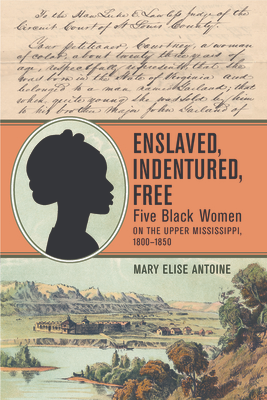Enslaved,
Indentured, Free: Five Black Women on the Upper Mississippi, 1800-1850
Mary Elise Antoine
US History
Wisconsin Historical
Society Press
October 5, 2022, 240 pp,
Ebook $11.99; paper $24.95
Buy on Wisconsin Historical Society
About the Book
The Northwest Ordinance of 1787 made slavery
illegal in the territory that would later become Illinois, Indiana, Michigan,
Ohio, Wisconsin, and part of Minnesota. However, many Black individuals’ rights
were denied by white enslavers who continued to hold them captive in the
territory well into the nineteenth century. Enslaved, Indentured, Free shines a
light on five extraordinary Black women—Marianne, Mariah, Patsey, Rachel, and
Courtney—whose lives intersected in Prairie du Chien, Wisconsin, during these
seminal years.
Focusing on these five women, Mary Elise Antoine explores the history of slavery in the Upper Mississippi River Valley, relying on legal documents, military records, court transcripts, and personal correspondence. Whether through perseverance, self-purchase, or freedom suits—including one suit that was used as precedent in Dred and Harriet Scott’s freedom suits years later—each of these women ultimately secured her freedom, thanks in part to the bonds they forged with one another.
My Review
Using public
records available, Mary Elise Antoine weaves together a story of early settlement
on the upper Mississippi, focused on Prairie du Chien, Wisconsin. Beginning
with Marianne, a freeborn black woman who remained free, the author researched
and shares about the lives of four other women whose lives touched.
Marianne was born
in the country along the southern Mississippi in the mid eighteenth century,
and married three times to French traders. Her second husband relocated to
Prairie du Chien. She was a unique figure who owned land, farmed, bore thirteen
children and practiced healing ways. The author notes that Prairie du Chien was
already diverse with mixed cultures. “In the early nineteenth century, race did
not automatically exclude people of color from various institutions on the prairie.
However, when white American men brought people of African heritage with them to
the prairie, they also brought racial inequality,” she writes.
The second subject,
Mariah, was brought to Prairie du Chien in 1816, one of 200 enslaved,
indentured, or hired working people brought to the area between 1816 and 1845,
almost all by members of the US Army. Because slavery was illegal in Illinois
Territory, Mariah’s owner changed the sixteen-year-old’s legal status to
indentured. Mariah later married a young soldier, though was “rented” by her
owner to others. When her owner left the area before her servitude was
concluded, he forced her to pay the rest of her contract in order to claim her
freedom. She and her husband divorced in 1839; she subsequently remarried and
moved to a home on land owned by Marianne.
A third woman,
Patsey, was brought to the area by the Indian agent in 1829. Again, the agent
forced Patsey into indentured servitude to get around the law; the indentured
work-around was apparently a common ruse, legally recorded wherever the family
moved, as well as moving their slaves in an out of territory where slavery was
illegal, or calling them variably servant or slave. Patsey had children who
were also indentured.
Courtney was
brought to Prairie du Chien as a servant for an army captain who was allowed to
claim her as an expense to his account, asking a few dollars a month
compensation, her clothing and one ration of food per day. He also provided a
description: five foot-four, black skin, eyes and hair. This girl was eventually
sold several times and moved to different locations in the area, even leaving
her son in slavery to one family. She finally was moved to St. Louis.
Rachel had been
purchased in St. Louis for a soldier with a young family stationed in Prairie
du Chien. When no longer needed, she was returned to St. Louis and sold again,
but this time Rachel took advantage of a Missouri law that allowed enslaved
persons to sue for their freedom based on prior residence in a free territory. she
filed suit in 1834 which was rejected for a word choice, being called a servant
by the soldier. With the help of her attorney, she appealed. During the time,
the attorney also filed a petition for Courtney, both of which were successful
in 1836. Courtney and her son returned to Prairie du Chien where she married
and went to live on land owned by Marianne.
The
text is somewhat dry and filled with much speculation as well as factual information
derived from public records as there are little or no personal records from
these women. The diligent research was excellent. Events of the time were
overlaid to provide some color. Laid out in seven chapters, five for the women
portrayed and two others describing circumstances and life at the time, the
book is a lively portrayal of life on the new frontier. Images of noted
individuals, places, and records and notes accompanying the text provide a nice
variation.
About the Author
Mary Elise Antoine is president of the Prairie
du Chien Historical Society and former curator at Villa Louis. She is the
author of the War of 1812 in Wisconsin and coeditor, with Lucy
Eldersveld Murphy, of Frenchtown Chronicles of Prairie du Chien.

No comments:
Post a Comment